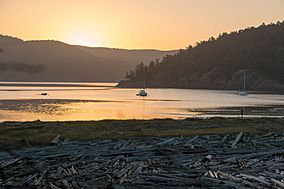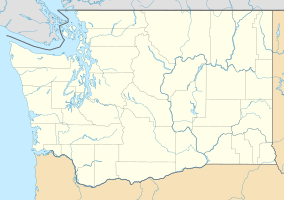Spencer Spit State Park facts for kids
Quick facts for kids Spencer Spit State Park |
|
|---|---|

Spencer Spit State Park, June 2015
|
|
| Location | San Juan County, Washington, United States |
| Area | 200 acres (81 ha) |
| Elevation | 154 ft (47 m) |
| Designation | Washington state park |
| Established | 1967 |
| Administrator | Washington State Parks and Recreation Commission |
| Website | Spencer Spit State Park |
Spencer Spit State Park is a fun place to visit in Washington! It's a public park managed by Washington State Parks. This park covers about 138 acres on the eastern side of Lopez Island. It has a long shoreline, perfect for exploring. The park looks out over the Strait of Juan de Fuca.
The park is special because it has two sand spits. These spits create a salty lagoon inside. This lagoon is a great stopping point for many birds. You might see Bonaparte's gulls, great blue herons, and kingfishers here.
Contents
Camping at Spencer Spit
Spencer Spit State Park is a great spot for camping! It has 37 places where you can set up your tent. Each spot has a fire pit for campfires. The park also has two restrooms and a dump station for waste. Just remember, there are no showers or hookups for RVs.
Most of the tent sites are big and offer privacy. Seven special sites are "walk-in" beach spots. These are closer to the beach but have less privacy.
The park also has two group camps.
- The large group camp can hold up to 50 people. It has ten walk-in sites and a big grassy area for everyone.
- The small group camp fits up to 20 people. It has three walk-in sites. One of these is an Adirondack shelter, which is a three-sided cabin with eight bunks.
When you camp, check-in time is 2:30 p.m. and check-out is 1 p.m. The park has quiet hours from 10 p.m. to 6:30 a.m.
Day Trips and Picnics
If you're visiting for the day, Spencer Spit has great picnic spots. There are two kitchen shelters, but they don't have electricity. Each shelter has four picnic tables, a barbecue grill, and a fire pit. Water is available nearby.
You can also find 15 picnic tables without shelters. Some of these are right on the spit or the beach.
The park has two miles of hiking trails that are part of the Cascadia Marine Trail. If you drive to the park, you will need a Discover Pass for your vehicle. The park is open from 8 a.m. until dusk during the summer. It is closed from October through March.
Fun Things to Do
Spencer Spit State Park offers many fun activities!
- Boating: There are twelve mooring buoys for boats on the Cascadia Marine Trail.
- Swimming: You can take a dip in the water.
- Bird Watching: Look for amazing birds like bald eagles, herons, and kingfishers.
- Hiking: Explore the park's trails.
- Views: Enjoy beautiful viewpoints and watch the ferries go by.
- Fishing and Clamming: Try your hand at fishing or digging for clams.
- Diving: Explore underwater.
- Beachcombing: Search for treasures along the shore.
Where is Spencer Spit Park?
The park is easy to get to! It's about 4.6 miles from the ferry landing. The roads are mostly flat, which makes it a great place to bike to. It's also only 3 miles from Lopez Village, a small town nearby.
History of the Park
Long ago, Native American tribes would visit this area. They would stop here to gather clams, crabs, and fish. This activity continued until 1946.
In the 1870s, Katherine and Franklin Troxell were the first settlers to live on this land. Later, they sold the land to Ray and Kathryn "Kate" Spencer. The Spencers owned land on Lopez Island and Blakley Island.
Between 1913 and 1920, the Spencers built a small cabin on one of the sand spits. You can still see the stone cellar of their old house near the spit. There's also a replica of a log cabin they built for guests at the tip of the spit. Ray and Kate lived here for 50 years!
In 1967, the Spencer family sold the land to the state of Washington. The state was interested in this undeveloped land because of the many blue herons that live there.
Plant Life at the Park
Spencer Spit State Park is home to many different plants and trees.
- Trees: You'll find alder, cedar, Douglas fir, and maple trees.
- Fruits: There are also apple trees, wild berries, and cherries.
- Other Plants: Look for eelgrass, ferns, foxglove, hemlock, moss, lichens, roses, seaweed, thistle, and yew.
Wildlife at the Park
The park is full of amazing animals!
- Birds: You might see crows, ravens, ducks, bald eagles, geese, gulls, hawks, herons, hummingbirds, ospreys, owls, woodpeckers, and wrens.
- Fish and Sea Life: The waters have clams, cod, crabs, perch, salmon, and shellfish. Sometimes, you might even see a pod of Southern Resident Orcas swimming by!
- Mammals: On land, look for chipmunks, deer, rabbits, raccoons, otters, and squirrels.
Clamming at Spencer Spit
Spencer Spit State Park is a popular place for clamming!
- The south side of the spit has sandy-gravel areas with eelgrass beds. You can find some mud lower down when the tide is out.
- The tip of the spit has larger rocks and more clams.
- The best place to dig for clams is in the muddy gravel flats on the north side of the spit. A salty lagoon drains through these gravel beds.
You can find several types of clams here:
- Native littleneck clams
- Varnish clams
- Butter clams
- Cockles
- Horse clams (The best spot for these is on the south side of the point.)
Oysters are not usually found in large numbers at this location.


